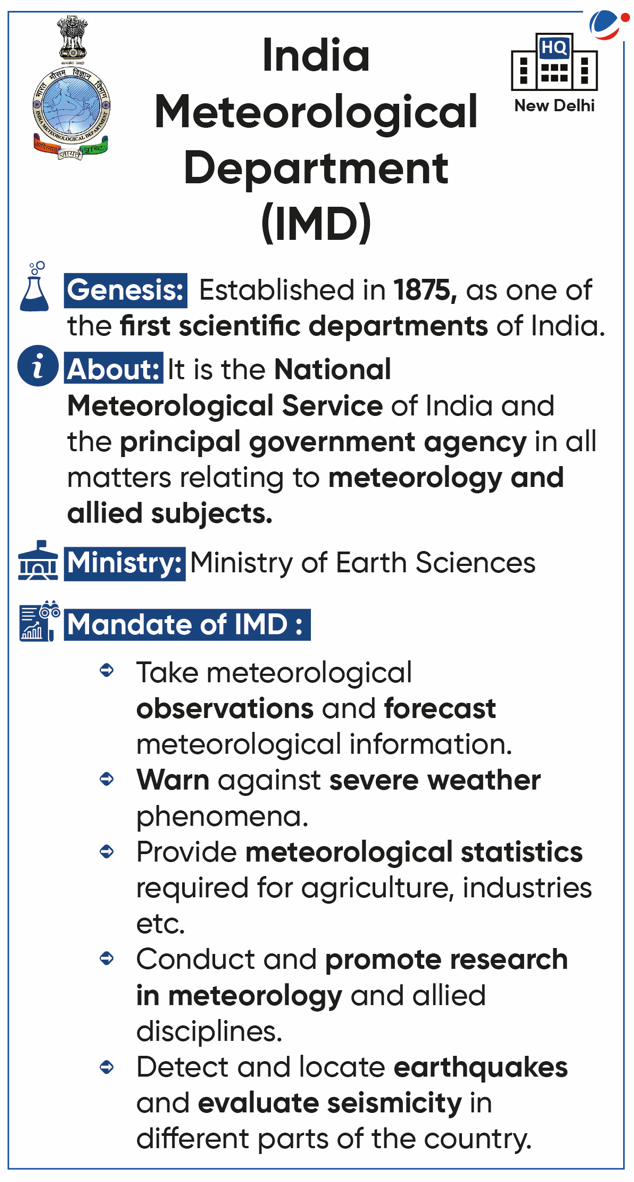Why in the News?
India Meteorological Department (IMD) celebrated the 150th Year of its establishment and service to India.

Recent Initiatives launched by IMD
- National Framework of Climate Services (NFCS): It is premised on the concept of the Global Framework for Climate Services (GFCS) launched by the World Meteorological Organization (WMO).
- NFCS aims to set up a platform that will provide climate information and services helpful for agriculture, energy, disaster management, health and water sectors.
- NFCS would enable every individual and organisation to be climate-smart and hence improve the economy of the country.
- Indigenously Developed Decision Support System
- About: A Web-GIS-based integrated Decision Support System (DSS) known as Weather Analysis and Forecast Enabling System (WAFES).
- Working: The WAFES serves as a visualization platform to analyse meteorological observations and prediction models, aiding decision-making for severe weather phenomena and their socio-economic impact.
- Components: DSS includes the Meteorological Information Communication System (MICS), Data Information Processing System (DIPS), Synthesized Integrated Visualization System (SIVS), and Public Weather Information System (PWIS).
- Target Areas: It provides real-time information for various sectors such as Urban, Power, Hydrology, Health, Energy, Agriculture, Transport and Tourism under the "UPHHEATT" initiative (for the cause of welfare).
- Other initiatives Launched
- Panchayat Mausam Sewa Portal: To help farmers in planning their agricultural activities.
- IMD’s Mobile App: IMD launched an integrated GIS-based interactive mobile app MAUSAM for all weather-related services.
Achievements of IMDObservations
Improvement in Forecast Accuracy
Communication System Networks
Appreciation
|
Challenges Faced by IMD in Accurate Weather Prediction
- Limited Weather Models: The IMD relies on weather models to make predictions. However, these models have limited capacity and are gradually being improved.
- Data Interpretation: Forecasters need to analyze multiple satellite images, radar data, and hints from models to enhance accuracy.
- Sometimes, misinterpretation occurs leading to forecast errors.
- Localized Extreme Weather Events: The IMD faces challenges in predicting cloudbursts, lightning events, and other localized extreme weather phenomena.
- Tropical Climate: India's tropical climate makes it difficult to predict weather accurately.
- A complex monsoon season can make it difficult to predict weather.
- Human Resource and Training: Recruitment, training, and retention of qualified personnel in meteorology can be a challenge, impacting the overall forecasting capabilities.
Way Ahead
- Enhanced Data Collection: Invest in advanced technologies and infrastructure to improve the accuracy and availability of climate data, including satellite observations, ground-based measurements, and ocean monitoring.
- Global Collaboration: Foster international cooperation and collaboration in sharing data, technologies, and expertise to address regional variations and global climate challenges collectively.
- Predictive Analytics and Artificial Intelligence: Leverage advanced predictive analytics and artificial intelligence tools to enhance the precision of climate predictions and identify patterns in complex climate systems.
- Early Warning Systems: Develop and implement robust early warning systems to effectively communicate and mitigate the impact of extreme weather events, especially in vulnerable regions.
- Capacity Building: Strengthen the capacity of meteorological agencies and institutions through training programs, knowledge sharing, and skill development to enhance their ability to monitor and predict climate trends.



